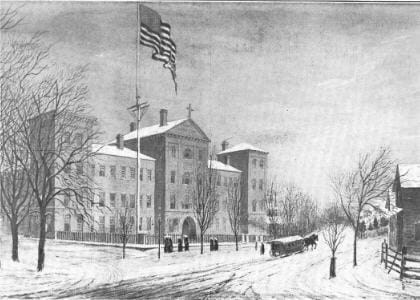General Content
St Mary’s became Rochester’s first functioning hospital when it opened its doors on September 17, 1857. The first union soldiers were received at the hospital in 1862, although it would not be until March of 1863 that St. Mary’s would be officially designated a federal “Army General Hospital.” In spite of its official status, by the end of 1863, the hospital had admitted relatively few wounded soldiers most likely due to the high cost of transporting the wounded from the battlefields to western New York. The district U.S. Surgeon and military inspector, Dr. Azel Backus, advised the Nuns at the hospital to prepare to receive a hundred soldiers in the near future but the federal authorities ordered the soldiers back to their original hospitals. Rochester’s city leaders agreed with Dr. Backus that western New York soldiers would far better in a western New York hospital and consequently sent a local delegation to Washington in May 1864 to make their case to the U.S. Surgeon General. Shortly after, official word was received to prepare to receive at once up to three hundred sick and wounded soldiers. On June 7, 1864, the afternoon train delivered 375 wounded soldiers to Rochester, 60 of which were sent to the Rochester City Hospital and the remaining were admitted to St. Mary’s. [1]
In February 1865, there were 398 union soldiers under treatment at St. Mary’s. Over the course of the hospital’s military service, the hospital’s facilities and resources were often overloaded. Frequently, corridors were utilized for patients and tents were pitched on hospital grounds to accommodate the monthly influx of wounded soldiers. Many invalid soldiers came to the hospital in pitiful and desperate states of health. A number of released prisoners from the infamous Andersonville Prison made their way to St. Mary’s in a condition described as “living dead”. Most were nursed back to health “through the patient efforts of the Sisters of Charity.” [2] Appeals to the community for food and supplies were often rewarded with generous donations.
It is difficult to accurately say how many soldiers were treated by St. Mary’s during the Civil War years. Some estimates have claimed four or five thousand patients but the remaining ledgers, evidence, and the final report by the hospital sent to Albany in December 1866 reports that there were “soldiers treated, 2500.”

[1]Robert F. McNamara, St. Mary’s Hospital and the Civil War, Rochester: St.Mary’s Hospital, 1961